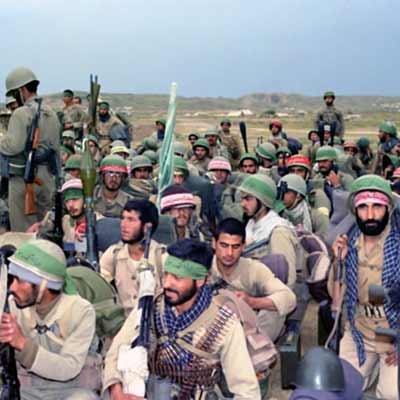Battles
Operation Valfajr 2
Leila Heydari Bateni
248 Views
In July 1983, Operation Valfajr 2 was launched in the western region of Piranshahr, West Azerbaijan Province. It aimed at seizing the Haj Omran Garrison, capturing the Baathist soldiers, and destroying anti-revolutionary bases and militant groups on Iraqi territory. The operation was successful, resulting in the capturing of several strategic heights and more than eighty enemy outposts.
As the earlier operations including Preliminary Valfajr (February 6, 1983) and Valfajr 1 (April 10, 1983) were carried out in southern Iran, military commanders shifted their focus to the western parts of the country. After preliminary analysis and planning, the execution of operations Valfajr 2, 3, 4, 5, and 6 was placed on the agenda. The key concerns in this series of operations included using limited manpower, minimizing casualties, preserving the overall combat power of the forces, ensuring success, and forcing Iraq to comply with the Islamic Republic’s demands.[1] If successful, the operation would result in gaining control over the movements of anti-revolutionary forces and providing support to Muslim Kurdish fighters in Iraq.[2] Furthermore, the seizure of Haj Omran Garrison, the villages of Zinu and Rayat, and the strategic Piranshahr–Rawanduz Road would lead to the destruction of Iraqi military supply centers and artillery bases on one hand, and the disruption of vital support networks for anti-revolutionary groups on the other.[3] It also could prevent any further attack on Piranshahr, facilitate the expansion of irregular operations inside Iraq, and pave the way for advancing towards the oil facilities near Kirkuk.[4]
Therefore, the western and northwestern command headquarters organized extensive offensive operations to force Iraq to withdraw its troops from southern Iran, thereby shifting the balance of power in the south in Iran’s favor. Operation Valfajr 2 was designed and executed in line with these objectives.[5]
The operation would cover the Piranshahr–Rawanduz Road in West Azerbaijan Province, particularly between the Qamtare and Tamarchin heights. The objectives included seizing the Sarkoob Heights and the Haj Omran Garrison, liberating strategic elevated ridges around the Piranshahr, gaining control over the town of Choman Mustafa (20 kilometers away from the Haj Omran Garrison), repelling Iraqi aggression, and taking Iraqi soldiers as captives. Moreover, blocking major transit routes used by anti-revolutionary elements to enter Iranian Kurdistan via the Tamarchin border, facilitating the infiltration of Iranian irregular forces into Iraqi Kurdistan, and enabling the movement of Iraqi Kurdish opposition into Iran were among other objectives of the operation.[6]
To carry out the operation, in northwestern Iran, the Hamzeh Seyyed al-Shuhada Headquarters and the Forward Command of the Army Ground Forces jointly commissioned the Malek Ashtar Headquarters to lead and coordinate Operation Valfajr 2.[7] Therefore, under the command of Malek Ashtar Headquarters, the operation was launched by units of the Army Ground Forces, the Islamic Revolutionary Guard Corps (IRGC), and Kurdish Peshmerga fighters[8] with 16 IRGC battalions, 6 infantry battalions, and 1 mechanized battalion of the Army Ground Forces engaging in. Due to the region’s rugged and elevated terrain, the Islamic Republic of Iran Army Aviation (Havanirooz) also provided partial support.[9]
Operation Valfajr 2 began at 1:00 AM on July 20, 1983, with the code-name “Ya Allah, Ya Allah, Ya Allah”. Initially, the Iranian forces advanced from the Qamtare and Tamarchin heights deep into Iraqi territory, engaging in irregular warfare in the Shahidan, Kohneh Lahijan, and Hawar Barkhala regions north of Haj Omran. Also, they attacked enemy positions in the Haj Omran area[10], encircling them from the southwest of West Azerbaijan and targeting them with artillery strikes.[11]
In the early hours of the operation, fierce clashes broke out in Rayat, Darband, and Gomrak where the Iraqi forces had to retreat. After the liberation of the heights overlooking the Gomrok, two critical Iraqi positions—King Heights and Khalan Post—were also seized by Iranians.[12] A few hours later, the Iranian forces managed to take control of several enemy bases. Likewise, destroying the bridges used for providing logistics and support along the main Piranshahr–Rawanduz Road, significantly weakened Iraqis’ defensive capacity. However, despite losing several strategic points in the highlands and open areas, Iraqi forces continued their resistance. On the eastern front, Iranian troops bypassed diversionary obstacles and penetrated Iraqi military positions, beginning minefield-clearing operations. In Qamtare and Tamarchin, heavy exchanges of fire continued, with the fiercest combat occurring at King Heights.[13]
By blocking the only logistical and supply route of the Iraqi army in the Darband, the Iranian forces managed to encircle approximately five Iraqi brigades (comprising about five thousand troops) along with all their equipment. By the morning of the second day, the Iranian units had cleared the area of anti-revolutionary elements and Iraqi military supporters.[14]
Through the second phase of the operation, the Iranian troops successfully advanced along the main Piranshahr–Rawanduz Road towards enemy positions. Faced with the superior combat capabilities of the Iranians, Iraqi forces left the battlefield through the mountains and valleys. In addition, despite launching extensive airstrikes against Iranian positions, Iraq suffered casualties and losses. During this phase, a large number of Iraqi army officers and non-commissioned personnel surrendered.[15]
On July 29, 1983, Iraqi troops stationed at Iranian highland checkpoints withdrew and formed three defensive lines consisting of trenches, shelters, and large-scale minefields. As a result, heavy clashes took place in those areas, and Iranian units encircled the heights surrounding Haj Omran.[16] In the following days, the Iranians bombarded enemy positions, broke through their defensive lines, and advanced several kilometers into Iraqi territory. They eventually captured the Haj Omran Garrison along with all of its armored equipment. Located six kilometers west of the Iran-Iraq border near the Piranshahr–Rawanduz Road, this garrison was one of the Iraqi army’s key command centers in the region and a crucial supply base for anti-revolutionary forces.[17]
Heavy clashes were underway at Height 2519 (Gardmand), which afterward was switched back and forth between the two sides before ultimately being captured by Iranian fighters.[18]
Finally, Operation Valfajr 2 came to an end on August 14, 1983, after 25 days of continuous battle and with the achievement of its designated objectives.[19]
The results of Operation Valfajr 2 included the suppression of anti-revolutionary groups, the infliction of heavy casualties on the enemy, and the capture of large amounts of ammunition, supplies, and Iraqi military equipment. Furthermore, around 270 square kilometers of Iraqi territory were liberated, several key locations were seized including Kalou Heights, and Iranians managed to take control of Choman Mustafa, villages along the Piranshahr–Rawanduz Road as well as more than eighty enemy strongholds and gathering points. Also, they captured strategically significant mountains and heights such as King (Azadi), Gardmand, Seyyed al-Shuhada (as), Taychi Kuran, Shahid Ayatollah Sadr Peaks (2120 and 1970), Heights 2062, Kado, Khader Sharafan, Sarsoul, and Khalan Hill near Piranshahr, Shivehrash Base, and liberated some villages including Minoutan Bala, Minoutan Paeen, Khuwar Bala, Khuwar Paeen, Alaneh, Rayat Bala, Rayat Paeen, Sumer, and Babakrab—all located around the Haj Omran region.[20]
In addition, several artillery ammunition depots, various cannons, and mortars were destroyed. Over 150 loaders and bulldozers, 60 tanks and armored personnel carriers, and 12000 light weapons were seized.[21] Among the most valuable achievements of this operation was capturing a counter-battery radar that Iraq desperately did not want to fall into Iranian hands.[22] Iraqi casualties in the operation were estimated at 4000 killed and wounded, with 510 captured.[23]
To complete the objectives of this operation, operations Valfajr 3, 4, and 5 were also carried out in western Iran.[24] In the meantime, France was going to deliver five Super Étendard aircraft to Iraq with which it could threaten Iran’s oil installations and move towards internationalizing the conflict.[25] In response, Western countries sought to prevent the further escalation of the Iran-Iraq War and pushed for a resolution to end the conflict. As a result, the United Nations Security Council adopted Resolution 540 on October 31, 1983.[26]
Following Iran’s success in operations Valfajr 2 and 3, Iraq escalated the bombardment of Iranian cities such as Andimeshk and Gilan-e Gharb.[27] A memorial ceremony for those who were martyred during the Valfajr 2 and 3, as well as in cities, was held at the Imam Khomeini (ra) Mosque in Tehran’s Grand Bazaar.[28]
[1] Nemati, Yaqoub, Karimi, Hojatollah, Akbarpour, Muhammad-Javad, Roozhshomar-e Jang Iran va Araq, vol. 27: Amadeh-Sazi-ye Amaliyat-e Valfajr 4 (Day-by-Day Record of the Iran-Iraq War, Vol. 27: Preparation for Operation Valfajr 4), Tehran: Markaz-e Asnad va Tahqiqaat-e Defa Muqaddas, 1394, p. 21; Jafari, Mojtaba, Atlas-e Nabardha-ye Mandegar (Atlas of Enduring Battles), Tehran: Soreh Sabz, 35th ed., 1393, Pp. 89-86.
[2] Ardestani, Hussain, Tajzieh va Tahlil-e Jang Iran va Araq, vol. 3: Tanbih-e Motajavez (Analysis of the Iran-Iraq War, Vol. 3: Punishing the Aggressor), Tehran: Markaz-e Motaleat va Tahqiqaat-e Jang, 1379, p. 56.
[3] Karimi, Nabi, Taqvim-e Tarikh-e Defa Muqaddas, vol. 35: Valfajr 2 (Calendar of Sacred Defense History, Vol. 35: Valfajr 2), Tehran: Markaz-e Asnad-e Enqelab-e Eslami, 1395, Pp. 1244-1245.
[4] Ardestani, Hussain, Tajzieh va Tahlil-e Jang Iran va Araq (Analysis of the Iran-Iraq War), vol. 3, p. 56.
[5] Jafari, Mojtaba, Atlas-e Nabardha-ye Mandegar (Atlas of Enduring Battles), p. 87.
[6] Karimi, Nabi, Taqvim-e Tarikh-e Defa Muqaddas (Calendar of Sacred Defense History), vol. 35, p. 1125; Ardestani, Hussain, Tajzieh va Tahlil-e Jang Iran va Araq (Analysis of the Iran-Iraq War), vol. 3, p. 56; Rashid, Mohsen, Atlas-e Jang Iran va Araq (Atlas of the Iran-Iraq War), Tehran: Markaz-e Motaleat va Tahqiqaat-e Jang, 1379, p. 86.
[7] Jafari, Mojtaba, Atlas-e Nabardha-ye Mandegar (Atlas of Enduring Battles), p. 89.
[8] Karimi, Nabi, Taqvim-e Tarikh-e Defa Muqaddas (Calendar of Sacred Defense History), vol. 35, p. 1131.
[9] Ardestani, Hussain, Tajzieh va Tahlil-e Jang Iran va Araq (Analysis of the Iran-Iraq War), vol. 3, p. 56.
[10] Karimi, Nabi, Taqvim-e Tarikh-e Defa Muqaddas (Calendar of Sacred Defense History), vol. 35, p. 1159; Jafari, Mojtaba, Atlas-e Nabardha-ye Mandegar (Atlas of Enduring Battles), p. 89.
[11] Karimi, Nabi, Taqvim-e Tarikh-e Defa Muqaddas (Calendar of Sacred Defense History), vol. 35, p. 1159.
[12] Ibid., p. 1128.
[13] Ibid., p. 1242.
[14] Ibid., p. 1157.
[15] Ibid., Pp. 1243-1244.
[16] Jang Iran va Araq, Amaliyat Jebhei-e Miyani, Vol. 12 (The Iran-Iraq War, Mid-Front Operations, Vol. 12), Tehran: Shakib, 1387, Pp. 349-350.
[17] Karimi, Nabi, Taqvim-e Tarikh-e Defa Muqaddas (Calendar of Sacred Defense History), Vol. 35, pp. 1157-1129.
[18] Ardestani, Hussain, Tajzieh va Tahlil-e Jang Iran va Araq (Analysis of the Iran-Iraq War), Vol. 3, p. 56.
[19] Karimi, Nabi, Taqvim-e Tarikh-e Defa Muqaddas, Vol. 36: Valfajr 3 (Calendar of Sacred Defense History, Vol. 36: Valfajr 3), Tehran: Markaz-e Asnad-e Enqelab-e Eslami, 1395, p. 1389.
[20] Ibid., p. 1157.
[21] Ibid., p. 1125.
[22] Rooznama-ye Jomhouri-ye Eslami (Jomhouri Eslami Newspaper), No. 1219, 24 Mordad 1362, p. 10.
[23] Atlas-e Rahnama 5, Karnameh-ye Nabardha-ye Zamineh (Atlas 5, Ground Battle Record), Tehran: Markaz-e Motalet va Tahqiqaat-e Jang Sepah-e Pasdaran Enqelab-e Eslami, 1381, p. 135; Jafari, Mojtaba, Atlas-e Nabardha-ye Mandegar (Atlas of Enduring Battles), p. 89.
[24] Rooznama-ye Etelaat (Etelaat Newspaper), No. 17083, 23 Mordad 1362, No. 17083, p. 2.
[25] Nemati, Yaqoub, Karimi, Hojatollah, Akbarpour, Muhammad-Javad, Roozhshomar-e Jang Iran va Araq (Day-by-Day Record of the Iran-Iraq War), Vol. 27, Pp. 19-20.
[26] Lotfollah-Zadegan, Alireza, Hemmati, Iraj, Roozhshomar-e Jang Iran va Araq, Vol. 28: Nokhostin Amaliyat-e Bozorg dar Shomal Gharb, Valfajr 4 (Day-by-Day Record of the Iran-Iraq War, Vol. 28: The First Major Operation in the Northwest, Valfajr 4), Tehran: Markaz-e Asnad va Tahqiqaat-e Defa Muqaddas Sepah-e Pasdaran Enqelab-e Eslami, 1396, Pp. 43-46.
[27] Rooznama-ye Etelaat (Etelaat Newspaper), No. 17083, 23 Mordad 1362, p. 2.
[28] Rooznama-ye Jomhouri-ye Esalami (Jomhouri Eslami Newspaper), No. 1220, 5th Year, 25 Mordad 1362, p. 1.





